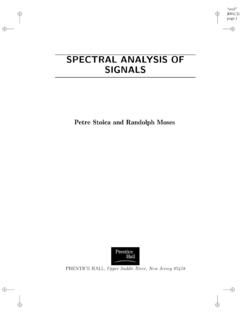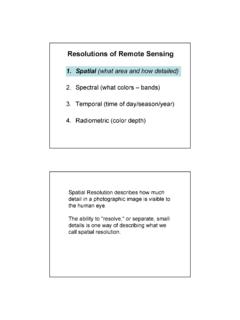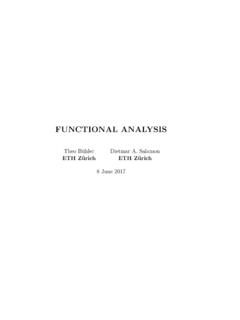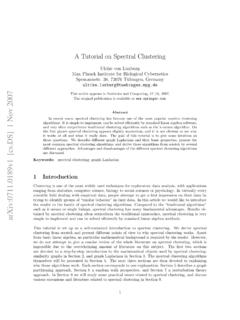Transcription of Spectral Analysis in R - McMaster University
1 Spectral Analysis inRHelen J. WearingJune 8, 2010 Contents1 Motivation12 What is Spectral Analysis ?23 Assessing periodicity of model output74 Assessing periodicity of real data115 Other details and extensions121 MotivationCyclic dynamics are the rule rather than the exception in infectious disease data, which may be dueto external forcing by environmental drivers or the inherent periodicity of immunizing (or partiallyimmunizing) infections or a combination of both. As an example, plotted in the figure below are weeklycase reports of childhood diseases from Copenhagen, Denmark during the mid-twentieth types of questions might we ask of these data? In this module, we introduce how to estimate theperiodicity of time series using Spectral Analysis . Specifically, we will look at recurrent epidemics fromeither simulated or real data.
2 We can often use these summary metrics as probes to match model outputto What is Spectral Analysis ?In a nutshell: the decomposition of a time series into underlying sine and cosine functions of differentfrequencies, which allows us to determine those frequencies that appear particularly strong or s briefly re-familiarize ourselves with sine and cosine functions!2 (4 pi t)sin(4 pi t)Thefrequency(f) of a sine or cosine function is typically expressed in terms of the number of cyclesper unit time. For example, in the above figure the frequency of each function is 2 cycles per unit (T) of a sine or cosine function is defined as the length of time required for one full , it is the reciprocal of the frequency (T= 1/f). In the above figureT= 1 sine wavesOne way of viewing Spectral Analysis is as a linear multiple regression problem, where the dependentvariable is the observed time series, and the independent variables are the sine functions of all possible(discrete) we have a time seriesxtof lengthn, for convenience assumenis even.
3 We can fit a time seriesregression withxtas the response and the followingn 1 predictor variables:cos(2 tn),sin(2 tn),..,cos(2(n/2 1) tn),sin(2(n/2 1) tn),cos( t)If we represent the estimated regression coefficients bya1,b1,..,an/2 1,bn/2 1,an/2, respectively, wecan writextasxt=a0+n/2 1 k=1[akcos(2 kt/n) +bksin(2 kt/n)] +an/2cos( t)(1)3 The cosine parameters,ak, and sine parameters,bk, tell us the degree to which the respective functionsare correlated with the data. This regression model is a finite Fourier series for a discrete time that because the number of coefficients equals the length of the time series, there are no degreesof freedom for error. The intercept term,a0, is just the mean, x, of the time series. The lowest possiblefrequency is one cycle, or 2 radians, per record length (which is 2 /nradians per sampling interval).
4 A general frequency, in this representation, iskcycles per record length (2 k/nradians per samplinginterval). The highest frequency is cycles per sampling interval ( radians per sampling interval).We should pay close attention to thesampling intervalandrecord length. Many time series are ofa variable that is continuous in time but is sampled to give a time series at discrete time steps. Thesampling interval (or sampling rate) constrains the highest frequency (known as the Nyquist frequency)that we can detect. For example, if we sample every week, we cannot detect cycles less than 2 weeks inlength. On the other hand, the length of the time series determines the lowest frequency that we periodogram quantifies the contributions of the individual frequencies to the time series regressionand is defined asPk=a2k+b2kwherePkis the periodogram value at frequencyk(fork= 1.)
5 ,n/2). The periodogram values canbe interpreted in terms of variance of the data at the respective frequency or period. A plot ofPk, asspikes, againstkis a Fourier line spectrum. The raw periodogram inRis obtained by joining the tips ofthe spikes in the Fourier line spectrum to give a continuous plot and scaling it so that the area equalsthe we have introduced the periodogram in the context of a linear multiple regression, the calcu-lations are usually performed with the fast Fourier transform algorithm (FFT) (and this is whatRusestoo).To summarize, Spectral Analysis will identify the correlation of sine and cosine functions of differentfrequency with the observed data. If a large correlation (sine or cosine coefficient) is identified, you canconclude that there is a strong periodicity of the respective frequency (or period) in the s consider a simple example to clarify the underlying mechanics of spectrum Analysis inRbeforewe discuss further details of the ExampleWe will create a simple time series, and then see how we can extract the frequency information usingspectral Analysis .
6 First, create a time variabletand then specify the time-dependent variablex:> t <- seq(0,200,by= )> x <- cos(2*pi*t/16) + *sin(2*pi*t/5)The variablexis made up of two underlying periodicities: the first at a frequency of 1/16 or period of16 (one observation completes 1/16 th of a full cycle, and a full cycle is completed every 16 observations)and the second at a frequency of 1/5 (or period of 5). The cosine coefficient ( ) is larger than the sinecoefficient ( ).4> par(mfrow=c(2,1))> plot(t,x,'l')> spectrum(x)050100150200 181e 03frequencyspectrumSeries: xRaw Periodogrambandwidth = the periodogram and automatically plots it against are three technical points we should briefly discuss (and some we won t but feel free to ask furtherquestions if you have any): pre-processing of the data smoothing of the periodogram how to makeRoutput better looking and give more intuitive estimates of the Spectral density!
7 Preparing the Data for AnalysisUsually, we want to subtract the mean from the time series. Otherwise the periodogram and densityspectrum will mostly be overwhelmed by a very large value for the first cosine coefficient (a0). InR, thespectrumfunction goes further and automatically removes a linear trend from the series beforecalculating the periodogram. It seems appropriate to fit a trend and remove it if the existence of a trend5in the underlying stochastic process is plausible. Although this will often be the case, there may be casesin which you prefer not to remove a fitted trend and this can be accomplished , whichgives the user more control over certain periodogram distributes the variance over frequency, but it has two drawbacks. The first is that theprecise set of frequencies is arbitrary, in as much as it depends on the record length.
8 The second is thatthe periodogram does not become smoother as the length of the time series increases but just includesmore spikes packed closer together. The remedy is to smooth the periodogram, and one way to do thisis by using a smoothing kernel of spikes before joining the tips. The smoothed periodogram is alsoknown as the sample spectrum. However, the smoothing will reduce the heights of peaks, and excessivesmoothing will blur the features we are looking for. It is a good idea to consider spectra with differentamounts of smoothing, and this is made easy for us with the R functionspectrum. The argumentspanis the number of spikes in the kernel. An alternative method for computing a smoothed spectrum is tocalculate the Fourier line spectrum for a number of shorter sub-series of the time series and average theline spectra of the Analysis inRThespectrumfunction defaults to a logarithmic scale for the spectrum, but we can change this bysetting the log parameter to no.
9 The default frequency axis is in cycles per sampling interval. It ismore intuitive to convert the frequency axis to cycles per unit time, we can do this by extracting thefrequency values thatRreturns and dividing by the length of the sampling interval. We should alsomultiply the Spectral density by 2 so that the area under the periodogram actually equals the varianceof the time series.> del< # sampling interval> <- spectrum(x,log="no",span=10,plot=FALSE)> spx <- $freq/del> spy <- 2* $spec> plot(spy~spx,xlab="frequency",ylab="spec tral density",type="l")6012345020406080100fre quencyspectral density3 Assessing periodicity of model outputLet s now look at how all this works on simulated data. We will start by simulating the seasonalSIRmodel that was introduced yesterday. First, specify the model> require(deSolve)> <- function (t, x, params) {+ with(+ (c(x,params)),+ {+ beta <- beta0*(1+beta1*cos(2*pi*t))+ dS <- mu*(N-S)-beta*S*I/N+ dI <- beta*S*I/N-(mu+gamma)*I+ dR <- gamma*I-mu*R+ res <- c(dS,dI,dR)+ list(res)+ }+ )+ }7 Then we simulate the model usinglsodaand calculate the periodogram on the last part of the timeseries (after discarding transients).
10 > times <- seq(0,100,by=1/120)> params <- c(mu=1/50,N=1,beta0=1000,beta1= ,gamma=365/13)> xstart <- c(S= ,I= ,R= )> out <- (lsoda(xstart,times, ,params,rtol=1e-12,hmax=1/120))> par(mfrow = c(3,1))> plot(I~time,data=out,type='l',subset=tim e>=40)> Iend<-subset(out,time>=40,select=c(I))> del<-1/120> <- spectrum(Iend,span=5,log="no",plot=FALSE)> spx <- $freq/del> spy <- 2* $spec> plot(spy~spx,xlab="frequency",ylab="smoo thed Spectral density",type="l")> plot (spy~spx, subset=spx<=2,xlab="frequency",ylab=" Spectral density",type = "l") #Zoom-in on low frequencies> [ (spy)] #Extract the dominant Spectral densityExercise the effects of changing amplitude of seasonality, 1, on the periodicity of thismodel. Be careful to distinguish between transient and asymptotic dynamics. What happens if you logtransform the simulated data and then apply the spectrum?





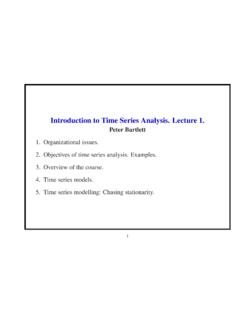

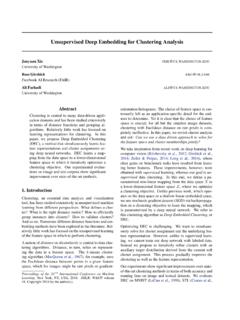
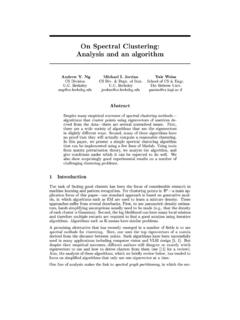
![[TS] Time Series - Stata](/cache/preview/f/9/9/c/5/9/9/f/thumb-f99c599f9adc31cbb3de3d6ed398bf7c.jpg)
